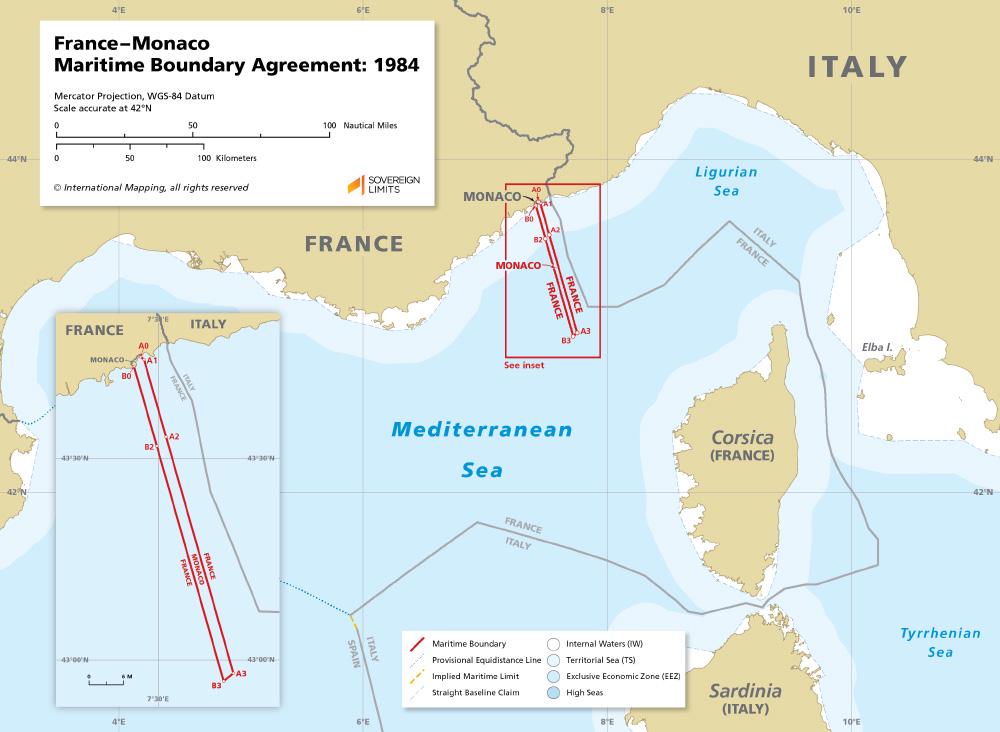Monaco's Territorial Waters Map


David Chen
Data Visualization Specialist
David Chen is an expert in transforming complex geographic datasets into compelling visual narratives. He combines his background in computer science ...
Geographic Analysis
What This Map Shows
The "Monaco's Territorial Waters Map" provides a clear visual representation of the maritime boundaries surrounding the principality of Monaco. It delineates the extent of Monaco's territorial waters, which play a crucial role in its sovereignty, ecological conservation, and economic activities. The map highlights the intricate relationship between land and sea, showcasing the territorial limits that define this tiny yet affluent nation.
Deep Dive into Monaco's Territorial Waters
Monaco, while renowned for its opulence and luxury, has a complex maritime jurisdiction that reflects its historical and geographical context. Situated on the French Riviera, it has a coastline stretching approximately 4.1 kilometers along the Mediterranean Sea. Monaco's territorial waters extend 12 nautical miles from its baseline, as established by international maritime law. This area not only encompasses the waters adjacent to its shoreline but also includes vital economic zones that contribute to the nation's prosperity.
Interestingly, Monaco's marine territory is crucial for various reasons. First and foremost, it supports a vibrant marine ecosystem, rich in biodiversity. The Mediterranean Sea is known for its unique habitats, which include posidonia meadows (seagrass) and various fish species, many of which are essential for both commercial and recreational fishing. Monaco has implemented several conservation measures to protect these ecosystems, ensuring that activities such as fishing and boating do not adversely impact the delicate balance of marine life.
However, the territorial waters are not just ecological treasures; they also serve as an economic lifeline for Monaco. The maritime zone facilitates important activities like tourism, fishing, and maritime trade. Monaco's luxury yachts and cruise ships often flood its ports, providing significant revenue for the local economy. The ports of Monaco, particularly Port Hercule, are pivotal for both tourism and the yachting industry, attracting visitors from around the world. In fact, the yachting sector alone is estimated to contribute hundreds of millions of euros to Monaco’s economy annually.
Furthermore, Monaco's territorial waters are strategically significant. They lie near major shipping routes in the Mediterranean, making them a critical point for maritime navigation. This positioning allows Monaco to exert influence over maritime traffic, enhancing its status on the international stage. Interestingly, the principality has engaged in various maritime agreements with neighboring countries, including France and Italy, to ensure the sustainable management of these marine resources.
Regional Analysis
When examining the territorial waters of Monaco in relation to adjacent regions, it's essential to consider the broader Mediterranean context. The Mediterranean Sea itself is a semi-enclosed body of water, bordered by 22 countries, which presents both opportunities and challenges for Monaco. The waters to the west of Monaco, near Nice and Antibes, are characterized by bustling tourism and heavy maritime traffic, while the eastern waters lead towards the Italian Riviera, known for its picturesque coastal towns.
What's fascinating is the variation in maritime governance across these regions. For example, while Monaco maintains strict controls on fishing to preserve its marine biodiversity, neighboring France has a more extensive fishing fleet that can impact shared fish stocks. This necessitates ongoing dialogues between Monaco and its neighbors to harmonize fishing practices and protect shared marine resources.
Additionally, the environmental pressures facing the Mediterranean—such as pollution and overfishing—have implications for Monaco's waters as well. Climate change poses a significant threat, with rising sea temperatures and altered marine habitats impacting local ecosystems. Monaco’s efforts to mitigate these effects through environmental policies are vital for maintaining the health of its territorial waters.
Significance and Impact
Understanding Monaco's territorial waters is crucial for several reasons. First, they are integral to the principality's identity as a coastal nation. The preservation of its marine environment not only supports local biodiversity but also enhances Monaco's appeal as a tourist destination. As climate change and environmental degradation threaten marine ecosystems globally, Monaco's proactive measures in conservation could serve as a model for other nations.
The economic implications of the territorial waters also cannot be overstated. As Monaco continues to develop its maritime economy, the balance between economic growth and environmental sustainability will be pivotal. Future projections suggest that sustainable tourism and marine conservation will become increasingly intertwined, potentially leading to innovative practices that benefit both the economy and the environment.
In summary, the "Monaco's Territorial Waters Map" offers more than just a glimpse of the sea surrounding this tiny country; it reveals a complex interplay between ecology, economy, and international relations. As Monaco navigates the challenges of the modern world, its territorial waters will undoubtedly play a central role in shaping its future.
Visualization Details
- Published
- October 1, 2025
- Views
- 56
Comments
Loading comments...